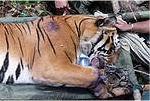A record number of endangered Florida panthers died this year due to car collisions, reports conservation organization, Defenders of Wildlife. Sixteen panther deaths from cars have been confirmed in 2009; an additional animal is suspected of having died from injuries due to a car in October. The mortality rate due to cars alone depletes the Florida panther population by over 15 percent. With less than 100 individuals left in the wild, every Florida panther killed before its time makes it more difficult for the animal to recover.
“Unless we take actions to avoid such tragic losses to Florida’s native wildlife, records such as these will continue to be reached each year as more and more roads and developments are built,” said Laurie Macdonald, Florida director for Defenders of Wildlife. “The toll that vehicle collisions are taking on the panther’s population is a serious obstacle to their recovery, and the roads and vehicles themselves are inhibiting the panther’s efforts to expand its range.”
 Florida panther. Photo by: US Fish and Wildlife Service. |
The organization recommends a number of solutions to save the rare panthers from further collisions, including accelerating the construction of wildlife crossings, tackling speed limits in panther areas, additional fencing, no new roads through wildlife habitat, and funding of the Florida Forever land acquisition program to purchase land for the panthers and other imperiled species.
The Florida panther has long been considered a subspecies of the mountain lion. However, recent genetic evidence suggests that the Florida panther may be too closely related to the North American cougar to be a distinct subspecies. These findings have yet to be unanimously accepted.
A large roaming hunter, the Florida panther is a flagship species, since protecting it across its wide range(over one million hectares) saves many other species and ecosystems.
Related articles
Tiger rescued from poachers in Malaysia perishes from injuries

(10/29/2009) Rescued in early October from a poacher’s snare, a Malayan tiger has died from stress and infection due to its injuries. The 120 kilogram (264 pound) male tiger died on October 19th in the Malacca Zoo after undergoing surgery to amputate its right foreleg, which two weeks before had been caught in a poacher’s snare and severely injured. “It broke my heart as I was there during the rescue. Everyone had such high hopes of the tiger being released back into the wild after its treatment at the zoo, and no one spoke of the in-betweens,” says Reuben Clements.
Tiger success story turns bleak: poachers decimating great cats in Siberia

(10/18/2009) There were two bright spots in tiger conservation, India and Russia, but both have dimmed. Last year India announced that a new survey found only 1,411 tigers, instead of the previous estimation of 3,508, and now Russian tigers may be suffering a similar decline. The Siberian Tiger Monitoring Program—a collaboration between the Wildlife Conservation Society (WCS) and several Russia government organizations—has found evidence that after a decade of stability the Siberian tiger’s population may be falling. This year’s annual survey, which covers only a portion of tiger habitat in Russia, found only 56 adult tigers: a forty percent decrease from the average of 95 tigers. While the cause of this year’s decline may be weather-related, researchers fear something far more insidious is going on.
Tiger brutally killed in zoo, body parts taken to sell for Chinese medicine

(08/25/2009) Poachers broke into the Jambi Zoo on Saturday morning in Indonesia. Using meat they drugged a female Sumatran tiger named Sheila and then skinned her in the cage. They left behind very little of the great cat: just her intestines and a few ribs. Authorities suspect that the tiger’s body parts will be sold in the thriving black market for Chinese medicines where bones are used as pain killers and aphrodisiacs.